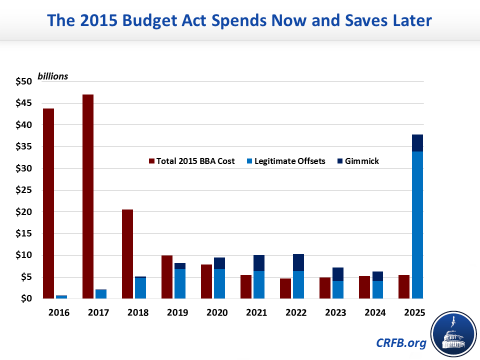Does the 2015 Budget Act Spend Now and Save Later?
Governor John Kasich claimed in the October 28 Republican Debate that the budget deal, formally known as the Bipartisan Budget Act of 2015, is “the same old stuff since I left. You spend the money today and then you hope you’re going to save money tomorrow.” In the sense that the Bipartisan Budget Act includes near-term spending in exchange for later cuts, this statement is largely true.

By increasing discretionary spending caps over the next two years, lifting the amount spent through the war accounts, and avoiding a spike in Medicare premiums, the bill spends about $118 billion – with $108 billion coming in the first three years. The $87 billion in offsets (the bill was not fully offset – see our analysis here), meanwhile, is extremely back-loaded, with only $8 billion coming in the first three years and $45 billion coming in the last three years of the ten-year budget window.

Thought of another way, 92 percent of the bill’s costs come in the first three years, while more than half of the pay-fors take place in the last three. Certainly this reflects the description that the bill spends money now to save tomorrow.
Still, it may be a mischaracterization to describe the future savings as only a “hope.” The legislation does not simply count on future actions from appropriators or uncertain changes in micro- or macro-economic performance. Rather, it enacted changes in law that will lead to reductions in mandatory spending and increases in revenue collection unless future lawmakers reverse the savings.
Yet even if these changes offer more than “hope,” there is no guarantee that future cuts will occur. As one example, policymakers are already working to reverse one of the cuts to crop insurance. And the broader point – that the legislation includes spending now and cuts later – is certainly true.


